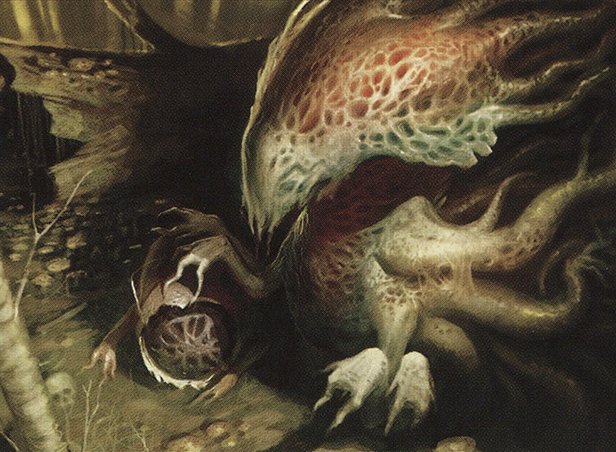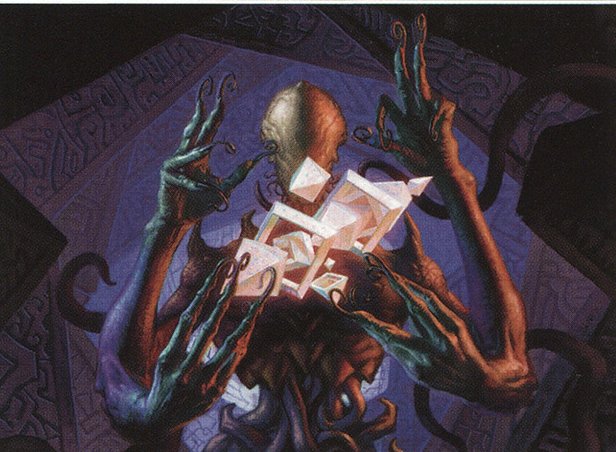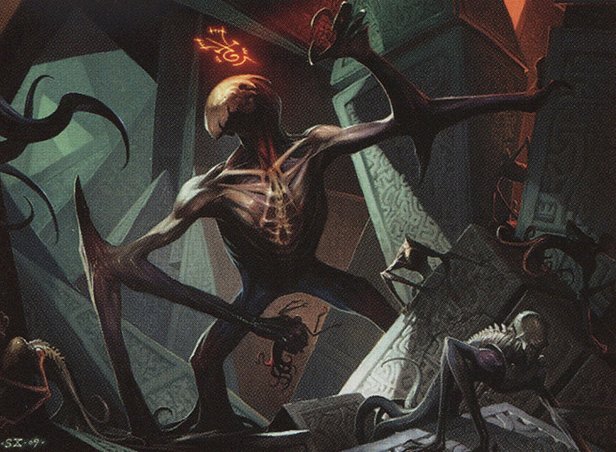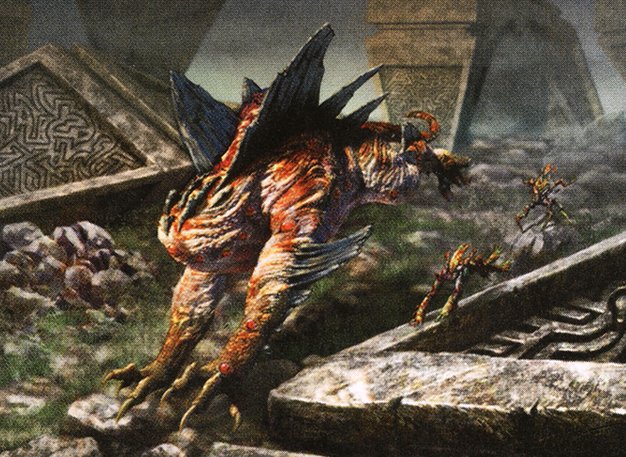The Three Brood Lineages
This content was deleted from the Magic website during an update. The original page can be accessed via Wayback Machine here.
By Doug Beyer

The three legendary Eldrazi trapped on Zendikar—Emrakul, Ulamog, and Kozilek—have risen again. Each spawns a so-called brood lineage of minions around it, lesser Eldrazi creatures that aid the three astral abominations in carrying out their inscrutable purposes.

Each brood lineage has a characteristic look that follows the look of its progenitor, including visual cues, skin textures, and themes. Today we do the unthinkable: we peer deep into the details of each Eldrazi lineage and discover how their looks differ. After today, you’ll be able to travel to Zendikar and identify the species of any Eldrazi monstrosity you see.
The Emrakul Lineage
The brood lineage spawned from Emrakul, the Aeons Torn has several hallmarks. The first and most recognizable is the spongy, fleshy latticework built into the anatomy of these creatures. These incomprehensible structures—sort of a cross between whale baleen and the cell wall structures of calcified plants—exist for no known purpose. Some merfolk scholars have speculated that the lattice somehow allows the Emrakul lineage to bend gravity more powerfully than the other lineages. You can see good shots of the strange latticework on several cards throughout Rise of the Eldrazi.


Eldrazi of the Emrakul lineage also bear otherworldly color schemes, merging deep blues with crusty ochres and shocking magentas. This odd coloration is common to most Eldrazi, as their once-astral forms are thought to reflect Zendikar’s light in unnatural ways, but the effect is especially prominent in the Emrakul lineage. Check out the coloration on Emrakul itself in cards like Gravitational Shift and Consume the Meek.


Another visual cue of the Emrakul lineage is the thin, ropy, tentacular growths that end in fingerlike or clawlike projections. Emrakul-lineage creatures use these growths to snare or bind their prey before ingesting their living energies, but they may also give rise to less obvious powers or senses.



Eldrazi Spawn of the Emrakul Lineage
Each lineage has its own form of squirmy, underdeveloped, mana-infused pupa: the Eldrazi Spawn. Eldrazi spawn are small—mere infants compared to the Brobdingnagian monstrosities they serve—but they serve an important role to the brood lineage. By some unknown process, greater Eldrazi can store consumed energy in their spawned underlings and then hatch greater Eldrazi by consuming the spawn in turn. Just like other Eldrazi, the anatomy and body plan of the spawn creatures follow the look of the rest of the lineage.
The spawn of the Emrakul lineage walk on two stumpy little legs, and have some of the same bizarre coloration and spongy latticework built into its anatomy.



The Ulamog Lineage
The lineage of Ulamog, the Infinite Gyre has its own visual hallmarks. The most notable feature is the skull-like bony plates that enshroud (or make up) the head region. The texture of bone combined with the creepy faceless implacability make the intentions of the Ulamog lineage impossible to read, and therefore make them quite frightful. It is not known what sensory organs these Eldrazi possess, or whether they have senses that defy scholars’ normal understanding of perception.



The Ulamog lineage is the most limb-crazy of the three lineages. Rather than true legs, many Ulamog-lineage creatures have masses of tentacles that support torsos that themselves branch into thick arms. Their long, sinewy arms are often bifurcated at the elbow. Some Ulamog-lineage creatures lean forward, low to the ground, and drag themselves along on their arms and tentacles, letting their featureless skull-plates lead the way.


Eldrazi creatures of all lineages alter the laws of nature just by their materialized presence on a plane. Note how the unnatural plant growth in the art of Growth Spasm resembles the writhing tentacles common to the Ulamog lineage.

The use of otherworldly color comes up again in this lineage. Ulamog-lineage creatures mix scabby reds with luminous purples and octopoid oranges. The tentacle growths of this lineage sometimes seem to deteriorate over time, leaving a corroded or rind-like texture to their outer tissue; it is not known whether this is a natural molting process or a reaction of the Eldrazi’s confinement in material existence.




Eldrazi Spawn of the Ulamog Lineage
The spawn of the Ulamog lineage are like squirming, miniature versions of the other creatures of the lineage. See the skull-like bony plates over the head, the bifurcated arm structure, and the mass of colorful tentacles at its base.


The Kozilek Lineage
The third lineage, that spawned from Kozilek, Butcher of Truth, shares a set of frightening physical characteristics. The most salient is the knobs or bladelike plates of some glossy black material jutting from, or hovering near, their bodies. These sharp projections tear effortlessly through physical substances, including armor and living tissue; yet the Kozilek lineage creatures seem not to use them intentionally as weapons. The projections may be defensive growths, organs of communication, or simply decorative features of the species; the extreme danger of the Eldrazi leaves little time for meticulous study.



Another feature of the Kozilek lineage is their often multi-legged, animalistic, or insectoid body plans. Some Kozilek-lineage creatures have bifurcated arms like the Ulamog lineage, but Kozilek limbs tend to branch with stranger, more awkward angles. The forked elbow structure is curious; it could indicate an adaptation used for climbing through caves and subterranean ruin passages, although it appears on some greater Eldrazi that are many stories tall. Although creatures of the Kozilek lineage often have animalistic skeletal structures, they always have their own horrible divergences from those natural forms, leaving them completely alien.


Creatures of the Kozilek lineage often have eyes or eyelike protuberances in odd places, such as at limb joints or scattered seemingly randomly along the creatures’ flanks. The appearance of such normal-seeming mammalian sensory organs on creatures such as the Eldrazi is jarring to say the least. Some have speculated that the eyes were grown as an attempt to mimic the life of Zendikar, the better to hunt such prey, but that the imitation failed or was halted, and only the eyes and vaguely bestial body shapes remain. The eyes do seem occasionally to aim and focus, but usually only at empty space—or perhaps they focus only on ineffable things that exist beyond the normal spectrum of visual light.



Eldrazi Spawn of the Kozilek Lineage
The spawn of the Kozilek lineage are squat, insectile, multi-eyed creatures that skitter on crablike limbs. These spawn exhibit swarming behaviors that mimic ant or termite colonies. Adventurers have discovered entire dungeons crawling with Kozilek spawn, which often precedes the emergence of new, even more horrible greater Eldrazi.



Portents and Possibilities
And there you have it. Since the Eldrazi are so enigmatic, little is known about their true natures, other than what can be seen or heard of them directly. Scholars may chart vague patterns in the migrations of the Eldrazi spawn-broods; explorers may uncover particularly fecund ruin sites where the Eldrazi lineages spawn more frequently; head-to-head battlemages may even discover magics that seem to work slightly better against them or locate unlikely weak spots in their otherworldly hides. But these discoveries tend not to hold for long, and the reports are anecdotal at best. The Eldrazi are not just forces of nature—they’re forces beyond nature, seeming to obey an insane set of pseudo-rules that don’t apply to the native denizens of Zendikar. So their natures are only guessed at, probed tentatively with prophetic bone-scattering rituals and glimpsed in the brain-trembling dream-stories of madmen.

Letter of the Week
Dear Doug Beyer,
Regarding your article “Rise of the Inbox”:A bit late, a mail after a mailbag article, but one thing really bugs me: why are Zendikar’s inhabitants still fighting each other, instead of unifying against the Eldrazi?
I could understand Puncturing Light’s grudge, maybe Grotag Siege-Runner’s desperation, but Smite and Leaf Arrow?
Greetings,
Toby
Hi Toby! Thanks for your email. You make a good point: the main conflict of Rise of the Eldrazi is between the natives of Zendikar and the otherworldly Eldrazi. We see this Zendikar vs. Eldrazi conflict played out in the art of cards like Repel the Darkness, All Is Dust, Time of Heroes, and Inquisition of Kozilek. But what about cards that depict more Zendikar vs. Zendikar conflict?

The answer is that while the Eldrazi and their predatory conquest of Zendikar is the conflict that hogs the spotlight, other conflicts still exist on the plane. Goblins still charge the gates at the Lighthouse to plant explosives, hoping to blast free some relic goodies. Elves still defend their woodsy homes with anti-aircraft magic. Kor nomads still defend themselves with combat magic, turning their minotaur foes’ weapons against them. Rise of the Eldrazi encapsulates a major turn in the Zendikar story, but it’s still a snapshot of everything that’s happening there on the plane, not just the emergence of the eponymous Eldrazi.

There are practical reasons to focus on a few of the other conflicts. Keeping the Eldrazi out of some card art here and there keeps the Eldrazi special, gives players some regular “color against color” scenes that they’re used to, gives the set continuity with Zendikar and Worldwake, and breaks up the visual overload of too many Eldrazi creatures showing up in the art of the set.

But I think it’s deeper than that. To me, showing other conflicts keeps the world feeling real—verisimilitudinous. Even on worlds assaulted by astral abominations of massive scale, there are moments when life is just about something else. There are still little fights that represent business as usual, that haven’t been totally eclipsed by the shadow of the Eldrazi—and I think a little bit of that makes the set feel truer.
Now, maybe the kor adventurer in the Smite art wanted to join forces with the minotaur against a squamous force of Ulamog-lineage horrors. Maybe all of the natives of Zendikar should put aside their trivial conflicts and unify against the Eldrazi. But the fact that petty problems still sometimes rise up over colossal ones—I think that makes the world feel human.
